This article needs additional citations for verification .(September 2014) |
Tokyo Metro and Toei Subway own or use the following types of rolling stock.
This article needs additional citations for verification .(September 2014) |
Tokyo Metro and Toei Subway own or use the following types of rolling stock.
Trains on the Ginza Line run in three-door six-car formations with no through trains into other suburban rail lines in Greater Tokyo. The maximum operating speed is 65 km/h (40 mph).
Trains on the Marunouchi Line run in three-door six-car formations with no through trains into other suburban rail lines in Greater Tokyo. The maximum operating speed is 75 km/h (47 mph).
Hibiya Line trains are 20-meter-long 7-car formations, with four doors per side. Prior to March 2017, Hibiya Line trains were 18 m long 8-car formations, with a mixture of three or five doors per side. Tokyu Corporation formerly operated trains from the Tokyu Toyoko Line into the Hibiya Line from 1964 until 2013, when through-services between the Toyoko Line and the Tokyo Metro Fukutoshin Line commenced operations.
Tokyo Metro
TRTA/Tokyo Metro
Tobu Railway
Tōzai Line trains are 20-meter-long 10-car formations, with four doors per side and longitudinal seating. The maximum operating speed is 100 km/h (62 mph).
Tokyo Metro
East Japan Railway Company (JR East)
TRTA/Tokyo Metro
JNR/JR East
Tōyō Rapid
Chiyoda Line trains are 20-meter-long 10-car formations, with four doors per side and longitudinal seating. Kita-Ayase Branch service trains run in three-car formations.
Tokyo Metro
JR East
TRTA/Tokyo Metro
Odakyu
JNR/JR East
Yūrakuchō and Fukutoshin Line trains are 20-meter-long 10-car (8-car for some Fukutoshin Line trains) formations, with four doors per side and longitudinal seating.
Tokyo Metro
Tobu Railway
Seibu Railway
Tokyu Corporation and Yokohama Minatomirai Railway (Fukutoshin Line only)
Sagami Railway (Sotetsu) (Fukutoshin Line only)
TRTA/Tokyo Metro
Odakyu Electric Railway (Yūrakuchō Line only)
Hanzōmon Line trains are 20-meter-long 10-car formations, with four doors per side and longitudinal seating.
Tokyo Metro
Tokyu Corporation
Tobu Railway
Tokyu Corporation
Tobu Railway
Namboku Line trains are 20-meter-long 6-car/8-car formations, with four doors per side.
Tokyo Metro
Tokyu Corporation
Sagami Railway (Sotetsu)
Toei Asakusa Line trains are 18 m long 8-car formations, with three doors per side. They are also of standard gauge (1435mm) as opposed to the 1067mm gauge used on most Japanese rail lines.
Toei
Keisei Electric Railway, Hokusō Railway, Chiba New Town Railway and Shibayama Railway
Toei
Keisei Electric Railway, Hokusō Railway, Chiba New Town Railway and Shibayama Railway
Keikyu Corporation
Toei Mita Line trains are 20 m long 6/8-car formations with four doors per side.
Toei
Tokyu Corporation
Sagami Railway (Sotetsu)
Toei
Toei Shinjuku Line trains operate in 20 m long 8/10-car formations and have four doors per side. They also use a 1372mm track gauge.
Toei
Toei
Toei Ōedo Line trains operate in 16 m long 8-car formations with no through trains into other suburban lines in Greater Tokyo. They are powered by linear induction motors.

The Tokyo Metro is a major rapid transit system in Tokyo, Japan, operated by the Tokyo Metro Co. With an average daily ridership of 6.84 million passengers, the Tokyo Metro is the larger of the two subway operators in the city; the other being the Toei Subway, with 2.85 million average daily rides.

The Tōyoko Line is a major railway line connecting Tokyo (Shibuya) to Yokohama. The line is owned and operated by the private railway operator Tokyu Corporation. The name of the line, Tōyoko (東横), is a combination of the first characters of Tōkyō (東京) and Yokohama (横浜). The Tōyoko Line is the mainline of the Tokyu network. The section between Den-en-chofu and Hiyoshi Station is a quadruple track corridor with the Tōkyū Meguro Line.

The Tokyo subway is a part of the extensive rapid transit system that consists of Tokyo Metro and the Toei Subway in Tokyo, Saitama, Chiba, the Greater Tokyo area of Japan. While the subway system itself is largely within the city center, the lines extend far out via extensive through services onto suburban railway lines.

The Tokyo Metro Hibiya Line is a subway line in Tokyo, Japan, owned and operated by Tokyo Metro. The line was named after the Hibiya area in Chiyoda's Yurakucho district, under which it passes. On maps, diagrams and signboards, the line is shown using the color silver, and its stations are given numbers using the letter "H".

The Tokyo Metro Namboku Line is a subway line owned and operated by Tokyo Metro in Tokyo, Japan. The line runs between Meguro in Shinagawa and Akabane-Iwabuchi in Kita. The Namboku Line was referred to as Line 7 during the planning stages, thus the seldom-used official name is Line 7 Namboku Line.
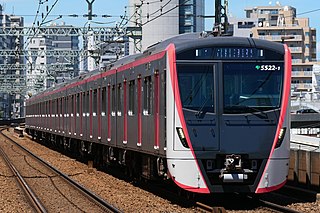
The Toei Asakusa Line is a subway line in Tokyo, Japan, operated by the municipal subway operator Toei Subway. The line runs between Nishi-magome in Ōta and Oshiage in Sumida. The line is named after the Asakusa district, a cultural center of Tokyo, under which it passes.
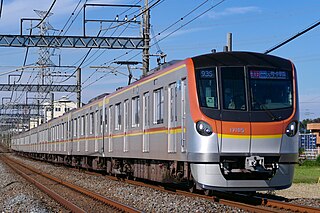
The Tokyo Metro Fukutoshin Line, formally the No. 13 Fukutoshin Line, is a 20.2-kilometer (12.6 mi) subway line operated by Tokyo Metro in west-central Tokyo and Wako, Saitama, Japan. The newest line in the Tokyo subway network, it opened in stages between 1994 and 2008. On average, the Fukutoshin Line carried 362,654 passengers daily in 2017, the lowest of all Tokyo Metro lines and roughly one third of its sister Tokyo Metro Yūrakuchō Line (1,124,478).

The Toei Mita Line is a subway line of the Tokyo Metropolitan Bureau of Transportation (Toei) network in Tokyo, Japan. The line runs between Nishi-Takashimadaira in Itabashi and Meguro in Shinagawa. Trains continue with direct service into the Meguro Line of Tokyu Corporation for Hiyoshi. The portion between Shirokane-Takanawa and Meguro is shared with the Tokyo Metro Namboku Line.

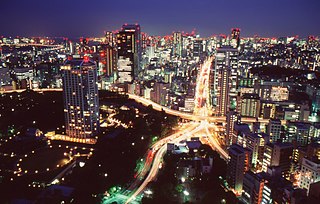
The transport network in Greater Tokyo includes public and private rail and highway networks; airports for international, domestic, and general aviation; buses; motorcycle delivery services, walking, bicycling, and commercial shipping. While the nexus is in the central part of Tokyo, every part of the Greater Tokyo Area has rail or road transport services. There are also a number of ports offering sea and air transport to the general public.

The Keisei Oshiage Line is a railway line in Tokyo, Japan, operated by private railway company Keisei Electric Railway. It connects Oshiage Station in Sumida and Aoto Station in Katsushika.

Pasmo is a rechargeable contactless smart card electronic money system. It is primarily used for public transport in Tokyo, Japan, where it was introduced on 18 March 2007. Pasmo can also be used as a payment card for vending machines and stores.

The Hokusō Line is a commuter rail line operated by the third-sector Hokusō Railway in Japan. It runs between Keisei-Takasago Station in Katsushika, Tokyo and Inba-Nihon-Idai Station in Inzai, Chiba. It is part of the primary Keisei route between central Tokyo and Narita International Airport through the Narita Sky Access Line. It uses the ATS Type 1 system.
5000 series may refer to several types of trains:
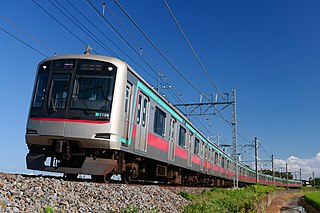
The Tokyu 5000 series is an electric multiple unit (EMU) train type operated by the private railway operator Tokyu Corporation since 2002 on many of its commuter lines in the Tokyo area of Japan.
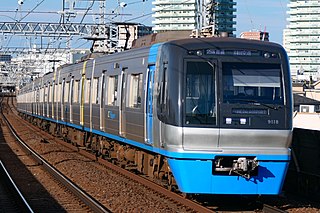
The Chiba New Town Railway 9100 series (千葉ニュータウン鉄道9100形) is a commuter electric multiple unit (EMU) train type owned by the third-sector railway company Chiba New Town Railway and operated by the Hokuso Railway on the Hokuso Line in Japan since 1994. The trains are nicknamed "C-Flyer", with the "C" standing for Chiba.

The Keisei 3700 series (京成3700形) is a commuter electric multiple unit (EMU) train type operated by the private railway operator Keisei Electric Railway in the Tokyo area of Japan since 1991.

The Sōtetsu Shin-yokohama Line is a commuter line operated by Sotetsu between Nishiya Station on the Sōtetsu Main Line to Shin-Yokohama Station. Sōtetsu has put its company names as a formal part of the line names, which is a first for the company.

The Tōkyū Shin-yokohama Line (東急新横浜線) is a commuter line operated by Tokyu Corporation connecting Hiyoshi Station on the Tōkyū Tōyoko and Meguro lines to Shin-yokohama Station on the Sōtetsu Shin-yokohama Line. Tōkyū has put its company name as a formal part of the line name, which is a second for Tōkyū, following the Tōkyū Tamagawa Line.
{{cite web}}: CS1 maint: archived copy as title (link){{cite web}}: CS1 maint: archived copy as title (link)